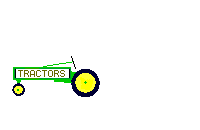
Baling Wire
Copyright Chuck Bealke, 1998
Because we raised cattle and fed the square bales of hay from a wire-tie baler, we had
an abundance of baling wire around the farm. It is incredibly useful, and when you
feed many bales you soon have lots of the stuff hanging about. If you have used it,
you might skip reading this; but if you are not familiar with the species, let me pass on
a few characteristics:
- It is a flexible wire, easy to handle and easy to cut with dikes (diagonal cutters) or
any of several types of pliers. A thicker aluminum wire will do the same things you
can do with baling wire and some things better, but it is not laying about by the mile
ready to use or pitch out. In fact, the main attraction of baling wire is often that
it's abundant and easy to use.
- It can be handled, twisted and wrapped around something without wearing gloves.
You can even learn to break off pieces without a tool by twisting it back and forth in a
certain way. (Of course, it is safer and wiser to use gloves and goggles when you work
with it.)
- It is pretty strong compared to twine, and mice and most other critters cannot cut it
with their teeth as they do twine. It is not strong enough for securing items to be
towed or for many other uses to which some people put it - until they learn the hard
way. Because it is so abundant and easy to shape, it is often used where it is not
adequate or safe to use.
- It starts to rust the day it's made. It will even rust indoors in the box it comes
in. Therefore, any time it is used out of doors, it is a temporary fastening
device. You sometimes see where it has been used to patch fences, even though
it will completely rust through in this application in a fraction of the time required to
rust out galvanized wire. Baling wire rusting between barbed wire strands (always
galvanized) is the cliche trademark of the lazy, poor, or clueless.
- It is avoided by hay users with expensive animals, such as pedigreed horses, because if
eaten after it's left to rust in a field or cut by a mower, it can poke through an
intestine during digestion. This can cause the death of pastured animals that are
not watched daily. This factor has helped twine balers take market share away from
wire machines.
Despite all its weaknesses, it's such marvelously useful stuff that it's almost
addictive. It just seems to fit some jobs in the shop perfectly, and I always had
some in my tractor tool box for temporary fixes or uses. We used to have a big bunch
of it behind the seat of the cattle truck. Used a loop of it as an extra
safety backup (every time we hauled) for the already-tight chain that held the tailgate in
place. For me, it would be hard to imagine skinning rabbits or securing tarps
without it. It was also ideal for supporting items to be painted by can or spray gun
or to be dipped in a tank for cleaning. When I left the farm and moved to the city,
I sure missed having it ready at hand. Took a bunch with me, but ran out of it.
The stuff the hardware stores sell for general purpose utility wire is a poor
substitute and would be even if they gave it away.
Click here to share your comments.





![]()
![]()